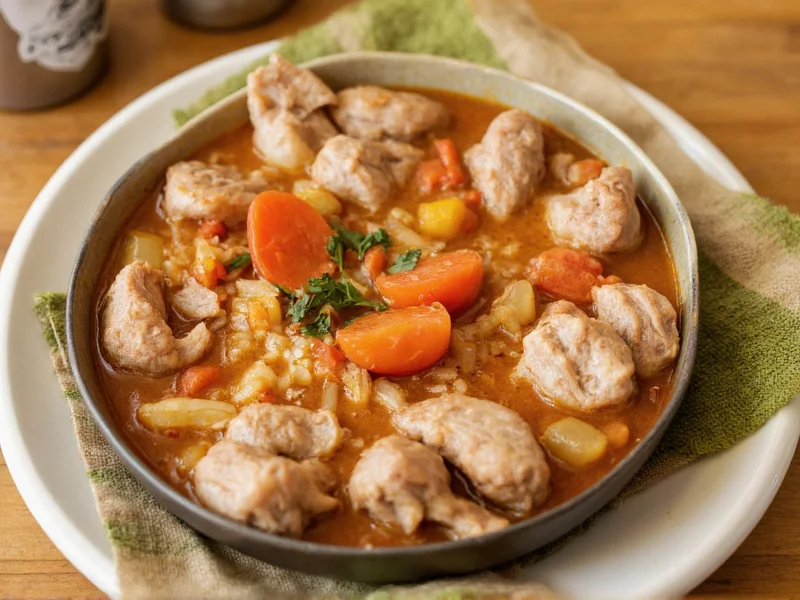Why Pork Makes Exceptional Soup
Pork offers unique advantages for soup making that many home cooks overlook. Unlike chicken or beef, pork bones contain abundant collagen that transforms into gelatin during slow cooking, creating naturally thick, velvety broths without additional thickeners. Shoulder cuts like pork butt provide ideal marbling that melts into the soup, enriching both flavor and texture. When properly prepared, pork soup recipes deliver comfort food satisfaction while remaining surprisingly light compared to other meat-based soups.
Essential Techniques for Perfect Pork Soup
Master these fundamental techniques to elevate your pork soup recipes from ordinary to exceptional:
| Technique | Key Benefit | Recommended Application |
|---|---|---|
| Blanching bones first | Removes impurities for clearer broth | All bone-based pork soups |
| Dry-brining pork | Enhances moisture retention | Leaner cuts like loin in soups |
| Layering flavors | Builds complex taste profile | All pork soup recipes |
| Finishing with acid | Brightens rich flavors | Before serving any pork soup |
Five Exceptional Pork Soup Recipes to Try
Classic Pork Bone Broth Soup
This foundational recipe creates a versatile base for countless variations. Start with 2 pounds of pork neck bones or trotters, blanched for 5 minutes in boiling water. Simmer with 8 cups water, 1-inch ginger slice, and 2 green onions for 3-4 hours. Skim impurities regularly. Strain and season with salt just before serving. For easy pork soup recipes for beginners, add sliced napa cabbage and tofu during the last 20 minutes of cooking.
Hearty Pork and Vegetable Soup
Perfect for pork soup recipes for cold weather, this one-pot meal combines 1 pound cubed pork shoulder with carrots, celery, potatoes, and kale. Brown the pork first, then sauté vegetables before adding 6 cups broth and simmering 45 minutes. The natural sweetness of roasted root vegetables complements pork's richness beautifully. This healthy pork and vegetable soup provides complete nutrition in a single bowl.
Authentic Vietnamese Pork Pho
Creating authentic Vietnamese pork pho at home requires attention to detail but yields extraordinary results. Use pork bones and oxtail for depth, charred onion and ginger for smokiness, and traditional spices like star anise and cinnamon. Simmer broth 6-8 hours, then serve with thin rice noodles, sliced pork loin, and fresh herbs. The key to success lies in balancing the five fundamental flavors: sweet, sour, salty, bitter, and umami.
Spicy Korean Pork Soondubu
This pork soup recipe with simple ingredients features soft tofu, minced pork, and gochujang in a fiery broth. Start with a base of anchovy-kelp broth, then add pork that's been marinated in garlic, ginger, and sesame oil. The dish finishes with gochugaru (Korean chili flakes) and soft tofu that melts into the soup. Serve bubbling hot in stone bowls with a raw egg that cooks in the residual heat.
Smoked Pork and White Bean Soup
For quick weeknight pork soup recipes, use smoked pork hocks or ham hocks with canned white beans. Sauté onions, carrots, and celery, then add 6 cups broth, 2 cups beans, and the smoked pork. Simmer 30 minutes until flavors meld. Remove the pork, shred any meat, and return to the pot. The smokiness permeates the entire soup, creating restaurant-quality results with minimal effort.
Ingredient Selection Guide
Choosing quality ingredients makes the difference between good and great pork soups. For pork soup recipes from scratch, select:
- Bones: Pork neck bones, trotters, or knuckles for maximum collagen
- Meat: Shoulder for richness, loin for leaner options, belly for luxurious texture
- Vegetables: Fresh aromatics (onion, garlic, ginger) rather than powdered versions
- Acid: Fresh lime or lemon juice to finish, never vinegar substitutes
Storage and Reheating Best Practices
Pork soups often improve with time as flavors meld. Cool soup completely before storing in airtight containers. Refrigerate for up to 4 days or freeze for 3 months. When reheating pork soup recipes for family meals, do so gently over medium-low heat to prevent the pork from becoming tough. Add a splash of water or broth if the soup has thickened too much during storage. The fat layer that forms on top when chilled actually protects the soup's flavor - simply remove it before reheating if desired.
Adapting Pork Soup Recipes for Dietary Needs
These versatile dishes accommodate various dietary requirements without sacrificing flavor:
- Low-sodium: Use homemade broth and add salt only at serving
- Gluten-free: Ensure soy sauce substitutes are certified GF
- Keto: Increase pork content and reduce starchy vegetables
- Meal prep: Store components separately for fresher results











 浙公网安备
33010002000092号
浙公网安备
33010002000092号 浙B2-20120091-4
浙B2-20120091-4